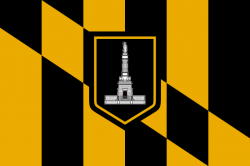 Zaloguj się, by zobaczyć współrzędne.
Zaloguj się, by zobaczyć współrzędne.
 1x znaleziona
1x znaleziona  0x nieznaleziona
0x nieznaleziona  0 komentarze
0 komentarze  0 obserwatorów
0 obserwatorów  Oceniona jako: b.d.
Oceniona jako: b.d.
 1 x rekomendowana
1 x rekomendowana
aby zobaczyć współrzędne oraz
mapę lokalizacji skrzynki
 Atrybuty skrzynki
Atrybuty skrzynki




 Opis
EN
Opis
EN
With all the discussion / controversy over the Confederate monuments in Baltimore, let me to to look more into Baltimore's various monuments and I found the website, Monument City Blog (MCB). Per their site, "Monument City is a human-scale geotagging project. We’re riding our bikes around Baltimore City to document historical monuments, memorials and markers with GPS, photos and other first-person data."
I started with some the Confederate memorials that the city, but am now expanding to others.

Per the MCB...One of the more ominous spots in the city, the Holocaust Memorial sits just a few blocks north of the Aquarium and takes up an entire city block. In the 1970s a ninth grade Baltimore Hebrew class told their teacher, Alvin Fisher, they didn’t believe the Holocaust occurred. Mr. Fisher promptly took a proposal for a memorial to Charm City’s Jewish Counsel, hoping to erase the unfortunate misconception. They granted his wish and the site was chosen, an area downtown owned by the Baltimore City Community College. The memorial consists of a monolith resembling a train with a steel gate symbolizing the internment of Jews in concentration camps. On the ground leading up to the large structure is a series of railroad tracks, tall grass growing from between the rails. At the southern end of the park a statue was erected, in 1988, that has since become the center-piece of the memorial. Two Baltimore businessmen and philanthropists, Melvin Berger and Jack Luskin, donated funds for the monumental flame. Dedicated in memory of the Night of Broken Glass, the 1938 destruction of Jewish homes, communities and synagogues by the Nazis, the sculpture is the creation of artist Joseph Sheppard and displays the bodies of victims engulfed in fire. Sheppard also sculpted the Pope John Paul II statue near the Basilica of the Assumption.
Baltimore’s Holocaust Memorial has seen many changes over the years. It was constructed in 1980 at a cost of $300,000 and consisted of a grassy mound and two 80 foot blocks of concrete. The stark scene became a haven for the city’s homeless and a plan to re-design the area was presented in 1995. Architect Jonathan Fishman was commissioned to create the empty rail yard that exists today. A plaque, it’s inscription written by author Deborah Lipstadt, was dedicated in 1997 upon completion of the project. Several Holocaust survivors attended the ceremony.
Logging Requirements:
1. Visit the site in person.
2. Post a respectful photo of your and / or your GPS at any portion of the monument.
3. Use the answers to the follwing quetions to determine the Log Password (ABC). The actual Log Password will be more than 3 characters long when you combind the answeres for A, B, & C.
A = Locate the plaque at the east of the "train cars". The first number listed is A.
B = Locate the plaque the west end of the "train cars". The name of the transportation company listed is B (multiple letters, _______ Transportation)
C = Earliest year listed on the large triangular plaque near the main sculpture.
I also created a few new Sighter locations in the area.
Join Geocachers Unlimited on Facebook.
 Wpisy do logu:
Wpisy do logu:
 1x
1x
 0x
0x
 0x
0x










